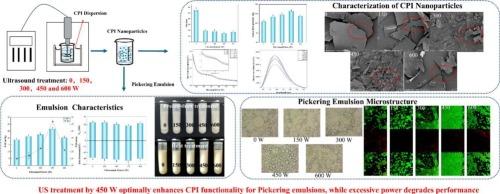超声介导制备稳定皮克林乳状液的鹰嘴豆蛋白纳米颗粒
IF 9.7
1区 化学
Q1 ACOUSTICS
引用次数: 0
摘要
研究了不同超声功率(0、150 W、300 W、450 W、600 W)处理对鹰嘴豆分离蛋白(CPI)稳定性的影响。扫描电镜证实,在450 W下,超声作用可使颗粒尺寸先减小后增大,最小的纳米颗粒(150.13±0.94 nm)。结构表征表明,α-螺旋含量先升高后降低,而β-薄片含量则相反。同样,经过超声处理后,zeta电位绝对值、本征荧光强度和表面疏水性均呈现先升高后降低的趋势。在450 W下,纳米颗粒改善了乳液稳定性,使液滴尺寸减小了18.96%,并将绝对zeta电位提高到50.53±0.35 mV (p < 0.05)。乳化活性指数(26.67±0.19 m2/g)和稳定性指数(47.02±1.01 min)显著提高(p < 0.05),浊度稳定性指数降低。显微镜分析表明,在450 W下处理的纳米颗粒稳定的乳液中,液滴分布更均匀,界面蛋白层更致密。此外,这些乳剂表现出增强的热稳定性和冻融稳定性。然而,过大的超声(600 W)会导致蛋白质重新聚集,对乳状液的稳定性产生不利影响。这些结果表明,适度的超声处理(450 W)可以有效地优化CPI纳米颗粒的性能,突出了它们作为食品工业中乳液体系有效稳定剂的潜力。本文章由计算机程序翻译,如有差异,请以英文原文为准。

Ultrasound-mediated fabrication of chickpea protein nanoparticles for stabilizing Pickering emulsions
This research investigated the impacts of various ultrasonic power (0, 150 W, 300 W, 450 W, 600 W) treatments on chickpea protein isolate (CPI) and their ability to stabilize Pickering emulsions. Ultrasonication initially reduced particle size before causing subsequent increase, with the smallest nanoparticles (150.13 ± 0.94 nm) achieved at 450 W, as confirmed by scanning electron microscopy. Structural characterization demonstrated that α-helix content initially increased then decreased, while β-sheet content showed the opposite trend. Similarly, absolute zeta potential values, intrinsic fluorescence intensity, and surface hydrophobicity all exhibited initial increases followed by subsequent decreases upon ultrasound treatment. At 450 W, nanoparticles improved emulsion stability, decreasing droplet size by 18.96 % and increasing absolute zeta potential to 50.53 ± 0.35 mV (p < 0.05). The emulsification activity index (26.67 ± 0.19 m2/g) and stability index (47.02 ± 1.01 min) were significantly improved (p < 0.05), along with a lower turbiscan stability index. Microscopic analysis revealed a more uniform droplet distribution and a denser interfacial protein layer in emulsions stabilized by nanoparticles treated at 450 W. Additionally, these emulsions displayed enhanced thermal and freeze–thaw stability. However, excessive ultrasonication (600 W) caused protein reaggregation, adversely affecting emulsion stability. These results indicate that moderate ultrasound treatment (450 W) effectively optimizes CPI nanoparticles properties, highlighting their potential as effective stabilizers for emulsion system in the food industry.
求助全文
通过发布文献求助,成功后即可免费获取论文全文。
去求助
来源期刊

Ultrasonics Sonochemistry
化学-化学综合
CiteScore
15.80
自引率
11.90%
发文量
361
审稿时长
59 days
期刊介绍:
Ultrasonics Sonochemistry stands as a premier international journal dedicated to the publication of high-quality research articles primarily focusing on chemical reactions and reactors induced by ultrasonic waves, known as sonochemistry. Beyond chemical reactions, the journal also welcomes contributions related to cavitation-induced events and processing, including sonoluminescence, and the transformation of materials on chemical, physical, and biological levels.
Since its inception in 1994, Ultrasonics Sonochemistry has consistently maintained a top ranking in the "Acoustics" category, reflecting its esteemed reputation in the field. The journal publishes exceptional papers covering various areas of ultrasonics and sonochemistry. Its contributions are highly regarded by both academia and industry stakeholders, demonstrating its relevance and impact in advancing research and innovation.
 求助内容:
求助内容: 应助结果提醒方式:
应助结果提醒方式:


